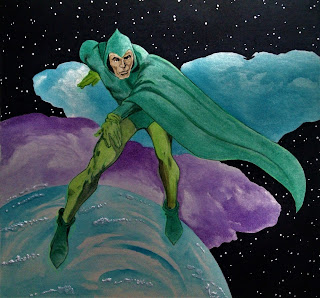LEGENDARY HEROES #40
THE GREEN LAMA
The first appearance of The Green Lama was in April 1940 in the pulp Double Detective magazine. The story was written by Kendall Foster Crossen who used the pseudonym Richard Foster, and the character was somewhat inspired by Theo 'The White Lama' Bernard who was an explorer, author, and yoga enthusiast. The character was originally conceived as The Gray Lama but tests of cover art were unsatisfactory so the color was changed to green. The character was created at the request of Frank Munsey Publishers who wanted a competitor for The Shadow at their rival publishers Street & Smith. Frank Munsey created the pulps. It was Munsey who had the idea to use high-speed presses to mass produce inexpensive, untrimmed, pulp paper magazines, creating magazines filled with various genres of action and adventure that were aimed at working class readers. One of the earliest publications by Munsey was Golden Argosy a weekly boy's adventure magazine. The title was changed to Argosy in 1888 and marketed to an older audience. Two other popular titles for Munsey's was Flynn's Detective Fiction and All-Story Love. Frank Munsey died in 1925 of a burst appendix and his estate, built on pulp magazines, was valued at $40 million.
The Green Lama was in reality Jethro Dumont, wealthy resident of New York City who was born in 1913 to his millionaire parents John Pierre Dumont and Janet Lansing. Jethro was well educated, receiving his A.B. from Harvard, M.A. from Oxford, Ph.D. from the Sorbonne, as well as attending college in Tibet. He inherited his family fortune of $10 million when his parents were killed in an accident while he was attending Harvard. Jethro spent 10 years in Tibet studying to become a lama, a Buddhist Spiritual Teacher, and acquired mystical powers in the process. He returned to America in order to spread the doctrines of Tibetan Buddhism (to relieve suffering by removing ignorance) only to realize that America was not ready to receive spiritual enlightenment. Jethro determined that he could accomplish more by fighting crime. He decided to never use a gun, that "this would make me no better than those I fight", though he relied upon superhuman powers that emerged upon the recitation of the Tibetan mantra "om mani padme hum". He also had several associates who aided him in his war against crime, including a mysterious woman known only as Magga whose true identity was never revealed.
The Green Lama proved to be successful, though not in the league of The Shadow, and author Crossen wrote 14 short novels that ran in Double Detective magazine until March 1943. Though appearing in a detective fiction magazine The Green Lama tales were considered science-fiction or supernatural fantasy as the Lama possessed superhuman powers. The stories portrayed Buddhism in a sympathetic and knowledgeable light, and unlike many of the contemporary characters from smaller publishers The Green Lama never fell into the public domain, as creator Crossen wisely retained all rights to his creation. Beginning in 2009 new stories were being written by different authors for various publications.
The Green Lama made his first comic book appearance in Prize Comics #7, December 1940 and ran until 1943 for a total of 27 issues. The stories were by Crossen with art by Mac Raboy who was known for his work on Flash Gordon and Captain Marvel Jr. This comic character had similarities to it's pulp counterpart but in this version he was more of a sorcerer with the ability to time travel, resurrect the dead, and do battle with the evil forces of Satan. The Green Lama fought Yellow Peril racketeers, Nazi agents, snake cultists, and followers of the occult. Author Kendall Foster Crossen then began his own comic publishing venture and named it Spark Publications and launched The Green Lama in his own self-titled comic books. Spark Publications only had three titles - Atoman Comics, Golden Lad, and The Green Lama - but they had a wealth of talent in the likes of Jerry Robinson, Mort Meskin, and Mac Raboy. The Green Lama ran in comics from December 1944 until March 1946 when Spark Publications ceased operations. The Green Lama next appeared on radio as a series on CBS with veteran voice actor Paul Frees providing the vocals of The Green Lama and Crossen, again, writing all of the stories. The series only lasted for 11 episodes from June 5 - August 20, 1949. And then CBS considered a TV series of The Green Lama for the 1950 season, but these plans were never realized. In the end, The Green Lama was probably the most obscure and unique character to come out of the Golden Age of Legendary Heroes.


.jpg)

.jpg)
Comments
Post a Comment